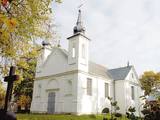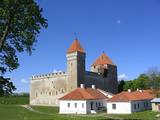| Нo | Название | Описание |
|---|---|---|
|
Lai nokļūtu līdz šim tornim, ir jāveic apmēram 20 – 30 min ilgs pārgājiens pa dabas taku no Penijē muižas gar Penijegi (Penijõgi) kreiso krastu. Te redzami bebru darbi un to celtās zaru mājas. No torņa paveras skats uz Kazari deltu, kas dabā izpaužas kā monolīts un nepārskatāms niedrājs. To vairākās daļās sadala Kazari un mazāka izmēra upītes. Katrai deltas daļai ir savs vēsturiskais nosaukums: no torņa pa kreisi no Penijegi redzama Lihula meri (Lihulas „jūra”), bet tās labajā pusē - Kloostri meri (Klostri „jūra”). Putnu vērotāji var iziet garāku (7 km) dabas takas loku, kas ved pa palieņu pļavām. Jārēķinās, ka pavasaros būs nepieciešami piemēroti apavi! Pļavas ierobežotās platībās apsaimnieko mājdzīvnieki, tādēļ neaizmirstiet aizvērt vārtiņus aiz sevis un netraucējiet to ikdienas gaitas! No maršruta nav atļauts novirzīties, lai netraucētu putnus. |
||
|
Das größte im Baltikum. Marathonloipe von Tartu, Wand der künstlichen Felsen und Trasse der Radmarathon. Skimuseum. Auf der Tehvandi-Sprungschanze ist ein Aussischtsplatform eingerichtet. |
||
|
Находится в построенном в 1911 году здании молочного комбината «Страупе». Производит молоко, кефир, пахту, сметану, сливки, творого, сладкие творожные крема, масло, йогурт и сыр. Продукцию можно приобрести в фирменном магазинчике (рядом с предприятием), где также можно купить сыры, произведенные партнерами по сотрудничеству – АО «Смилтенес пиенс», и ООО «Латвияс пиенс». Одно из пяти латвийский предприятий, которые имеют право производить традиционный продукт, включенный в схему «Гарантированной традиционной особенности» ЕС – сыр «Яню». Продуктам присвоены знаки «Зеленая ложечка» и «Латвияс лабумс». Для групп организуют дегустации и предлагают ознакомиться с деятельностью кооператива по производству и переработке молока. |
||
|
Один из молодых городов Латвии, в 2013 году отметит свой 20-летний юбилей. В Саласпилсе находится несколько научных организаций Латвийского масштаба (в советское время они создавались как научные центры) - Биологический институт, Институт неорганической химии, Институт физики, Национальный ботанический сад, в советское время, а теперь уже бывший Саласпилсский атомный реактор и Институт лесоведения «Силава». Последнее десятилетие в городе развивается инфраструктура, образовались просторные районы особняков. В 1996 году в Саласпилсе построили новую католическую церковь. В сущности – это спальный район Риги. |
||
|
One of Northern Europe's oldest universities (founded in 1632). Many famous people and scientists have studied here. Main building (1804. – 1809.) is one the country's most excellent monuments of Classical architecture. |
||
|
В хозяйстве выращивают несколько пород шиншилл, которые и демонстрируются. Можно увидеть декоративных птиц - фазанов, павлинов, голубей, разные породы кур, а также степного сурка, карликовых коз, бурундуков, кроликов, пони и др. Здесь можно купить шиншилл, декоративных птиц и других животных, а также перепелиные яйца, шкурки шиншилл и сувениры. Рыбалка в прудах. |
||
|
Музей был создан для того, чтобы создавать представление о Латышской сельской среде, знакомить с историей развития отраслей сельского хозяйства, распространять материальные и нематериальные свидетельства ведения сельского хозяйства и жизни на селе в Латвии с конца 19-го века до наших дней. Интерес посетителей подогревается широким спектром сельскохозяйственной техники для обработки и ухода за землей, для сбора урожая, а также различными инструментами. |
||
|
Предлагается порыбачить в пяти приусадебных рыбных прудах и посушить рыбу. Хозяин готовит форель горячего копчения, копченых карпов и на костре варит уху. Покупка куриных яиц. |
||
|
Каунатский Римско-католический костёл Пресвятой Девы
Марии построен в 1850 году на месте сгоревшего деревянного,
средства – помещицы Зузанны Друвы. В костёле находится икона
„Мария посещает Святую Элизабет”.
|
||
|
Один из наиболее красивых садов Ницы, где особенно любимы хосты и клены. Коллекция хостов насчитывает более 130 сортов, а количество кленов уже достигло 25. У большого пруда можно покормить рыбок и насладиться красотой сада. И хозяева, и гости в восторге от впечатляющей вывески дома, появившейся после долгих поисков. Сад добился успехов на конкурсах самых красивых дворов Ницы и Латвии. |
||
|
Находится на ул. Базницас, д. 7. Красивое деревянное здание, построенное около т.н. мостика Кулдигской Венеции через Алекшупите в 1670 году. На крыше здания можно увидеть один из старейших и самых красивых флюгеров города. |
||
|
История каменного замка уходит к 13-ому веку . В подвальных залах замка постоянные выставки, которые представляют природу и историю Сааремаа. В замке с мая по август действуют ремесленные мастерские (кузница, обработка стекла, гончарная мастерская, обработка камня), предлагая гостям как усладу для глаз , так и радость творчества для рук. Интерес представляет и расположенный поблизости тир для стрельбы из лука, где после попадания в цель можно самому чеканить монеты. Из филиалов Сааремааского музея советуем посетить хутор-музей Михкли на западе Сааремаа (деревня Вики, волость Кихельконна; +372 454 6613, www.saaremaamuuseum.ee), где можно увидеть как архитектурные достопримечательности, так и объекты культурного наследия. |
||
|
The Sietiņiezis cliff is on the right bank of the Gauja River between Valmiera and Jāņmuiža (follow signs along the road). There is a circular nature trail here. Sietiņiezis is one of the largest white sandstone cliffs in Latvia, up to 15 m high and around 500 metres long. There is an interesting diversity in form here, with small caves and niches, erosion-based ravines, as well as sandstone formations which are reminiscent of poles. The word "sietiņš" refers to "sieve," and the cliff is so called because bees have drilled holes into it for time eternal. From the southern part of Sietiņiezis, you can get a good look at the ancient Gauja River valley, and all around it are lovely pine forests. There is a place on the banks of the Gauja which is meant for campfires and meals. |
||
|
Nahe der Beerkopfdüne ist im Frühling 2006 „ein Brand der Jahrhunderte” gewessen. Es wurde der hundert Jahre alte Wald in der Fläsche von 235h ausgebrannt. Ein Pfad mit Holzbelag. |
||
|
Lake Salājs is full of bays and islands. Alongside Lake Little Solojs, which is next to Lake Salājs, is the Milka castle hill and a leisure facility there. This is a beautiful area, and it is protected for environmental purposes. |
||
|
Гостей кафе ждет полезная для здоровья, традиционная для данного региона и экологически чистая еда. Также здесь можно познакомиться с народным культурным наследием, разными легендами, а также приобрести лакомства и сувениры. |
||
|
The first half of this section leads through magnificent coniferous forests, especially in the Järvevälja landscape reserve, where the trail is surrounded by beautiful dunes in the north and a raised bog in the south. It is well worth visiting the kiosk at Rannapungerja to buy smoked fish – the Lake Peipus vendace (rääbis) and some local farm produce. In the second part, the Forest Trail winds along the coast of the beautiful Lake Peipus. During the summer, when the water level in the lake is lower, beautiful, sandy beaches with wide shallows appear. Past Alajõe, the highest dunes of Lake Peipus (up to 20 m) rise on the landscape, providing a distant view of Lake Peipus, one of the largest lakes in Europe. |
||
|
Mustjala Mustard Saaremaa предлагает горчицу и чатни собственного приготовления. Любой желающий может их продегустировать и выбрать себе сорт по душе. Здесь также проводятся мастер-классы ‒ после их посещения ты всегда сможешь самостоятельно приготовить свою любимую приправу. |
||
|
The Krimulda Lutheran church is seen as one of the oldest in Latvia. It was built in the early 13th century, soon after the territory of Kubasele was conquered. Over the subsequent centuries, it has been rebuilt many times. Alongside the church is a meditation maze called "Lily Blossom." When the Liv warrior Kaupo fell in battle near Vīlande in 1217, his remains were supposedly interred at the church. Local residents, true, describe a small hillock that is near the church as the grave of Kaupo. The site is located alongside the little Runtiņupīte (Runtiņš) river, on the right bank of which is a manmade cave that is approximately seven metres deep. It is the Kubesele Cave or the Runtiņala Cave. The Kubesele castle hill is on the left bank of the Runtiņupīte. The Kubesele Nature Trail starts at the church. If you hike down the trail, you'll see all of the aforementioned objects and others. The trail leads to the Gauja River where, on the right bank, is the Great (Runtiņš) Rock. Nearby you'll find anchor blocks installed by rafters on the river. |
||
|
Находится на улице Лиела, д. 84, в Гробине (т.н. Докторат), где прошло детство писательницы З. Маурини. В Докторате гостили многие известные работники латышской культуры, что оказало большое влияние на будущую писательницу. В 1997 году в здании была создана комната памяти, где писательница жила с 1898 по 1921 год. Посетители могут осмотреть разные экспонаты и увидеть фильм, посвященный столетию З. Маурини. |
||























